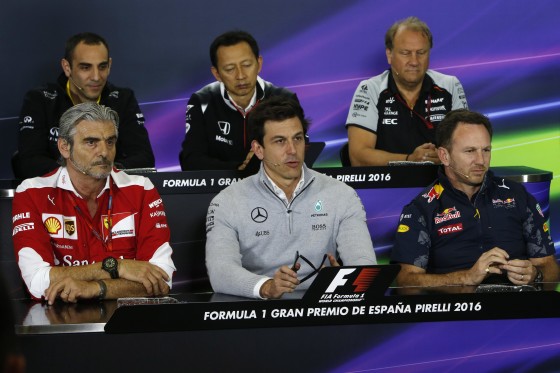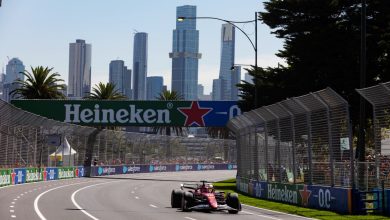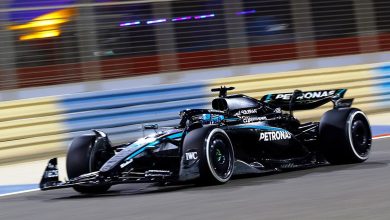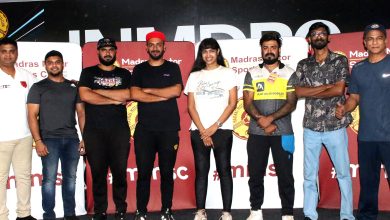Force India has done a great job technically and the upgrades are working: Bob Fernley

 TEAM REPRESENTATIVES – Cyril ABITEBOUL (Renault Sport), Yusuke HASEGAWA (Honda), Robert FERNLEY (Force India), Christian HORNER (Red Bull Racing), Toto WOLFF (Mercedes), Maurizio ARRIVABENE (Ferrari)
TEAM REPRESENTATIVES – Cyril ABITEBOUL (Renault Sport), Yusuke HASEGAWA (Honda), Robert FERNLEY (Force India), Christian HORNER (Red Bull Racing), Toto WOLFF (Mercedes), Maurizio ARRIVABENE (Ferrari)
PRESS CONFERENCE
Let’s start with a question to you all. After much debate and discussion the FIA has now confirmed the revised engine regulations for 2017 to 2020. Are you pleased with the final agreement? Maybe we could start with Cyril.
Cyril ABITEBOUL: Yeah, I mean, it’s an agreement, so we are pleased with this agreement in particular, but I think what’s good now is to have a clear understanding of what’s coming up for the next few years. We all know stability is important, so we have agreed for some stability up to 2020. We have also agreed for price reduction for customer teams, that’s clear, that’s agreed. There is also a clear target to get the performance to converge, because we all believe that it’s important for Formula One. We believe it is happening anyway, but there is this clear target. It cannot be a guarantee, because no one can guarantee performance. You can’t guarantee performance in the wind tunnel, same thing with engine. But we all know what we have to do. It’s good, it’s a relief, because we know what we have to do and we can make plans for the future.
Maurizio?
Maurizio ARRIVABENE: I’m very happy about that, because the most important news is that they talk and they move and that has opened the competitiveness for all of us and also the development. In terms of stability it’s absolutely fine, so I have no doubt that this decision is going to help the sport.
Robert?
Robert FERNLEY: I think we’ll reserve our position.
Meaning?
RF: We’ll reserve our position.
Hasegawa-san, your thoughts?
Yusuke HASEGAWA: Yes, not everything is good to the engine manufacturer, but it’s good to fix the rules and I believe the rules continue to 2020, so the rule stability is very good to us as a big company so it is good.
Christian?
Christian HORNER: I think what Bob was trying to say is that it is a little underwhelming. It’s a very soft agreement between the manufacturers and the FIA. It tickles the price, deals a little bit with convergence, the obligation to supply doesn’t really apply, so it’s a very weak agreement. Unfortunately it’s a shame more couldn’t be done, but I suppose if you look on the bright side it’s better than nothing.
A weak agreement Toto?
Toto WOLFF: I just want to digest what I just heard in the last five minutes. We achieved a major price reduction over two years. We have opened up development scope for others to catch up. We have designed an obligation to supply so no team runs out of an engine contract. We have found a mechanism how performance convergence could be trigged. Lots of good things, many months of hard work in trying to get everybody on the same page, I think it’s a good step forward.
OK, a few individual questions then, starting with Cyril. We’re waiting to see what the engine upgrade brings. Can you tell us a little bit about the strategy behind the 2016 development programme and what you expect this upgrade to bring in terms of lap time?
CA: Well, the strategy is fairly straightforward. Quite opposite to what’s happening in the chassis regulation with a major change between ’16 and ’17, nothing changed on the engine regulation between ’16 and ’17, so anything you can bring in ’16 is good for ’16 and ’17, so there is no question mark or debate about how do you… do I split my resources between this year and next year? That’s part of the development strategy, that’s part of the programme. It’s not all that we have in the pipeline; it’s a good chunk of it. It’s a good chunk for this year and we hope that it will be reducing some of the gap to the gentleman sitting in the front row to the benefit of Christian and Red Bull.
Robert, coming back to you: tough start to the year, eight points on the board after four races. You’ve brought some updates this weekend, but can you sum up where you are in early 2016 and where you’re heading?
RF: Well, from our point of view it’s disappointing that the results that we have don’t justify the car and it’s the exact opposite of where we were last year, where the results really flattered us to a certain degree. We’ve had two races where both cars got taken out in the first lap and the other two races, where a red flag and the safety car didn’t help out strategies at all. I think we just have to keep doing the right things all the time and it’ll come back to us. I’m very confident. The team is doing a great job technically. This upgrade appears to be working where we want it and we’ll climb our way back to where we want to be.
Thank you for that. Hasegawa-san, going back to the discussion about engine regulations, obviously part of this new FIA agreement regards manufacturers supplying more than one team. Honda has always maintained it would welcome supplying multiple teams in Formula One, but have you actually begun any negotiations with anybody for 2017.
YH: As a matter of fact, we don’t have concrete negotiations, although we have some conversations with some teams, but unfortunately we can’t make a conclusion with some teams. Currently our position is that we have to wait until the situation changes.
But it’s true to say that you still welcome the opportunity to supply a different team?
YH: Welcome is a different word. I think I have an obligation to contribute to Formula One society, so we are preparing our resource, but still we are not strong enough to provide multiple teams. We are preparing now.
Toto, back to you. The team wrote and open letter to the fans after all the conspiracy theories circulating around Lewis Hamilton’s technical problems. How did that come about and what was achieved by it?
Toto WOLFF: Well, since a while already we are trying to have a pretty transparent communication with all the stakeholders. We engage a lot through social media with our fans and this was one more exercise in that direction, which we felt was necessary to say where we are coming from.
And how do you feel it worked out?
TW: I don’t know. Clearly with Lewis and Nico in the car they polarise. There’s always going to be controversy around that, but I feel it worked out OK.
OK, thanks for that. Christian, obviously the big talking point going into this weekend is the switch of Daniil Kvyat and Max Verstappen. What part did you play in that and how hard do you think it will be for Verstappen to adjust to your car mid-season, given how little Formula One experience he has?
CH: I think Red Bull are in a unique situation where we’ve got four drivers contracted to the team. Two have always been loaned to Toro Rosso and within their contracts we have the ability to move drivers around and with the benefit of four relatively competitive cockpits we have the ability unlike other teams to move drivers from team to team. There’s been some discussion for a little while, because obviously we monitor and follow the performance of each of the drivers very carefully, not only in the car but outside the car, through the development programme and through the tools we have back at the factory as well and basically we reached a conclusion to say there’s never an ideal time to move things around but if we are going to move it why don’t we get on with it, do it in time for the European season. It puts our best foot forward in Red Bull Racing, it gives Dany Kvyat the chance to continue to develop in the Toro Rosso environment and that was the basis of the decision. In the meantime it also allows us to tidy up options and secure things for the future as well, so all very positive.
Coming to you Maurizio: the cars are a lot faster this year than in 2015. I think Kimi was three seconds quicker in that FP2 session than he was 12 months ago. In terms of your performance as a team do you feel that until now you haven’t been able to show the real Ferrari performance due to the various issues that you’ve had at the races?
MA: It’s true, but can you repeat… our car is faster, three seconds to last year?
FP2 last year, yes.
MA: Thank you, I like to hear that! The problem is they [Mercedes] are faster than us! No, I mean we have a programme of development. We try very, very hard, taking also a big risk at the start of the season. We have also a bit of bad luck, being honest. But I’ve said many, many times this Mercedes teams is the strongest of the last 10 years. So to beat them you need to take some risks and you need to work very, very hard. I’m talking about this with respect for them but with determination that sooner or later we can catch up.
QUESTIONS FROM THE FLOOR
Q: (Vladimir Rogovets – Sb Belarus) We see here representatives of different teams. My question is for all. In Formula One it’s very important to have good driver, good chassis and good engine – how many per cent can you give to the role of driver, the importance engine, of chassis?
CA: I think you should ask Toto, because he has all of it!
TW: One doesn’t go without the other. You cannot give percentages. The best driver in a weak chassis will not be competitive and, if he has a weak engine, it will not help either. So you need to align the stars, try to get the best possible driver in the best possible car with a very competitive engine.
Anyone else like to have a stab at it? Christian, your thoughts.
CH: Yeah, I think Formula One, the three elements should have equal weight: the driver, the chassis and the engine. So if one of those elements isn’t quite right, the other two can compensate. I think in today’s Formula One, with the recent engine changes I think we’ve offset that balance, and so you’ve probably got – I don’t know – 50 per cent engine, 25 per cent chassis, 25 per cent driver. I think the encouraging thing is the regulations that are in the pipeline for next year should rebalance that: it should make chassis a little bit more of a factor, which is going to challenge the driver more. So, hopefully for 2017 it should balance up a little.
Do you agree with those ratios Robert?
RF: I think there’s an old saying that a good driver can always make a poor car look good – but not the other way around. So I think both of them are important.
Hasegawa-san, any thoughts on this?
YH: It is a bit difficult to tell the number. To me, every element has a one-third importance I think – to me.
Maurizio?
MA: I’m not good with percentages but being logical and straightforward, how can you go there and run around without the driver? And then you need to also have a good driver. At the moment it’s a good balance in between the three. Maybe the engine is more important this year without doing percentages. Next year, I agree with Christian, you could have the chassis that is going to take up a bit more importance, making all the races a bit more interesting and also challenging the drivers’ ability. But I think, looking at this year, it’s very spread out between the driver, chassis and engine – and if I have to talk in percentages, with something more for the engine.
Cyril, you tossed the question to Toto at the beginning. Do you want to say anything about it?
CA: I think in theory we would like an equal breakdown between the three elements – but that never happens. The one thing that should not happen is that the engine is taking too much weight for the simple reason that you have fewer engine suppliers than you have teams. So, if suddenly the engine is taking more weight you are giving too much power to one single entity, which is exactly what happened in truth for Mercedes. Nothing wrong with that, just because they did a brilliant job – but it’s never too good for the sport.
Q: (Silvia Arias – Parabrisas) Yesterday in this room Lewis Hamilton said something like “Ferrari is hungry to win, of course, but we still have potential to develop our engine.” I would like to ask Mr Arrivabene how optimistic you can be this year trying to beat Mercedes when the driver says something like that? And is Ferrari able to develop still the engine this year?
MA: Looking at the first four races saying that I’m optimistic… it’s a bit too much. But of course because we know exactly what’s happened there. In Melbourne victory was absolutely possible. In Bahrain maybe yes, and then we have two different circumstances in the other two races. Of course I’m optimistic. If you’re asking me when, most probably we have to share the question in between me and him to understand precisely but I mean of course we are trying to do our best, and we are determined and optimistic.
Q: (Rodrigo Franca – VIP Magazine) Question for all. If each one of you can make a single change to the regulations for next year, what would it be?
CH: Mercedes engines for everybody free of charge.
And in the real world?
CH: Well, we have a chassis regulation change. I think anything that gives the driver more predominance… Formula One is about man and machine, or woman and machine at the absolute limit. I think at the moment the drivers have too much of an easy time. We don’t see or get to appreciate their skill levels – which are huge. I think anything that can be encouraged within the regulations that differentiates more between the drivers, so we get to appreciate more the real skill they have, I’d be all for.
Toto?
TW: I think if we leave everything as it is now, we have changed the regulations for a new aerodynamic concept for next year and that’s pretty exciting. I’m actually quite happy with the direction we are heading towards.
Maurizio?
MA: I’m quite happy too, being honest. Concerning the show, I think from my point of few, as Ferrari, we are building car, engine, gearbox and chassis and not growing driver, so for us it’s good what we have. If you are asking me what you really, really like to change, I threw up on the table maybe ban the simulator. In this way you can go testing to the track, you can promote Formula One, you are not going to spend millions to update the simulator. Why not? You have to think that keeping the exclusivity of Formula One, it doesn’t mean that Formula One has to be viewed only at the race time and disappearing in between the grand prix. I mean to promote Formula One you have to see the car running and to test the tyre you have to do testing. Now we have something that, in my opinion is quite artificial like the simulator. If you are asking me, OK, tell me what you want to change. It is not a proposal for FIA. It is my thought.
Cyril
CA: Well, as said, we know what we have now and it’s too late anyway to change but the one regret that we have is on fuel limitation, on fuel quantity. Because even though we support and appreciate the message that Formula One needs to be fuel efficient, the product is fuel-efficient first and foremost and secondly the fuel quantity limitation is going against the performance convergence which we all think is important. So if you are to ask me that, the one which I would waive, also because we want the driver to be constantly in a situation to attack and not to have to manage too carefully their fuel, so that would be the only one – but it’s a small detail.
And how much fuel in a perfect world would you want to give them?
CA: I would take away completely the quantity just for the message. Formula One is not endurance, it is not LMP1, it is a short race, it is about being able to attack constantly. So it’s joining a little bit the point made by Christian a bit earlier. If you ask me what is the fuel quantity that is needed in order to be fuel sustainable at all races, I think we are talking about three to five kilograms of fuel will make it. But again, just for the sake of the message and the simplicity of the message and not have negativity that Formula One is about precious drivers and so on and so forth, I would take away any limitation.
Hasagawa-san?
YH: This is also a personal opinion, so not a proposal for the FIA but if we could reduce the penalty of the number of the usage of the engine it would be nice. Of course I respect the longer mileage engine and the durability is a very important challenge for the engine people but the current penalties, I think are too big and complicated to introduce to the fans. I think we should be better to reduce the penalty to the engine change on usage on engines.
Bob?
RF: I think there’s a lot of work gone into producing the regulations for next year which I’m quite comfortable with as they are – but I think the underlying problems for Formula One are in what is a very inequitable distribution of income. I think we need to get that right to make sure its sustainable.
Q: (Sergio Alvarez – One Magazine) Maurizio, this weekend this Spanish Grand Prix is the anniversary of Michael Schumacher’s first win for Ferrari; is there any special feeling inside the team and do you remember what you were doing that Sunday?
MA: Yes, Michael is in our hearts every single day. He’s part of the history of Ferrari. I was here that day and I remember very well the hug that Michael gave to me later on after the race and what we were drinking in the cup. It was a very very good feeling. I think it was wine or something. I don’t like… being an Italian, I don’t drink wine! It was something that for me was very strange but good.
TW: I don’t remember unfortunately. I remember those glorious Schumacher years, an era when Ferrari was dominant with Michael there and like he’s very very much part of Ferrari, he’s very much part of Mercedes as well but for that particular Sunday, no recollection.
CH: Yes, I remember it very well. I was watching it on the TV. I remember being a Williams supporter at the time and David Coulthard and Damon Hill both managed to screw it up and Michael did a great job that day in the rain, in conditions that were pretty appalling. It’s a great equaliser and in a car that was nowhere near the level of a Williams performance, he was in a class of his own that day and it was a very very impressive drive.
RF: This goes back to what I said before, that a great driver often makes an underperforming chassis look very very good, and that’s what Michael did. He was quite remarkable.
YH: When was that? Sorry, I don’t remember. I wasn’t in Formula One.
CA: I think I was working on my exams unfortunately.
Q: (Dieter Rencken – Racing Lines) Cyril, you said earlier on that performance convergence is a target. Fabrice Lom said earlier on that it will be monitored rather than regulated. Now are the four power units suppliers represented here confident that convergence can actually be achieved within certain limits, two per cent or 0.3s? And that one or other team won’t possibly be fudging their performance for as long as this monitoring is carrying on and then just shooting off ahead on their own thereafter?
CA: That’s one hell of a tactic. No I think that’s what we have to aim for, that’s the target, that’s our ambition and I think frankly that’s achievable. When I look at what we have on our dyno, what we have on simulation but also on dyno, so I’m talking about physical product, we really have a good good hope that we can do that, so obviously just looking at what we are doing. What I don’t know is what Mercedes, Ferrari, Honda are doing but there is naturally a law of diminishing returns, as we all know, which, after some time, is starting to kick in. Maybe we need to ask the gentlemen in front what is their plan, but I think it’s achievable and talking about the tactics that will be followed by any team in order to change, to create a reaction in change, frankly I think that’s a bit remote and I think there is an element of change that will not be controlled by such a team that would kick off the process so I don’t really believe that.
MA: I think in our position we will continue to develop our engine and without stopping that for sure so then if, somehow, the convergence is achieved, it’s something that we need to discuss, but no discussion that the developing and looking for the performance is in the DNA of our team.
TW: Yeah, I would agree. The regulation stays stable, the development scope is opened up a bit so it is pretty logical that the field is going to converge. We are going to try to do everything to not make this happen.
YH: Even if we don’t have a rule, we have to catch up, otherwise we can’t be here, I think. Naturally we have to catch up, yes.
Q: (Dieter Rencken – Racing Lines) Toto, your company: although the team is based in the UK, the head office is based in Germany. Cyril, exactly the same with yours except that it’s France. Christian, yours is Austria and the UK. With this looming Brexit vote coming up, have you looked at the impact on a British organisation with a European head office and what could possibly happen operationally? I’m not asking for political comment at all, but purely operationally, how you see it could affect your teams in future?
CH: Well, we had George Osborne come round the other day but he never mentioned Brexit which was quite impressive. Look, we’re a sporting team, we’re based in the UK, we’re not going to get involved in politics. If it happens, it happens. If it stays it doesn’t make a great deal of difference to us, so we’ll deal with it as and when, if it should happen.
TW: When I took the job in 2013 I was told by my boss, Dieter Zetsche, don’t comment on politics so I’m not commenting on politics. We’re sporting, as Christian says, and we just have to get on with our job.
CA: Without talking about politics, the only thing we would have to look at carefully is the effect on the currency, because as an organisation we are exposed to a number of foreign exchange rates including dollars because the revenue of FOM is not euros, it’s dollars so we would have some impact there. But apart from that, I don’t see any other implications.
Q: (Fabrizio Corgnati – diariodelweb.com) For Ferrari, Mercedes, Renault and Honda: as manufacturers, do you think that modern Formula One still gives a good return of investment to help improving the road car sales?
YH: Technical side or promotion side? Marketing side. Of course it is very difficult to say, the current Honda position is not a very good effect to the mass production but definitely, the image of Formula One can still have a good image for the mass production side as well, yes.
CA: Well, obviously I think we reply to that answer with the decision that we made at the end of last year and obviously, as you can imagine, we’ve done a lot of analysis in order to form that decision which was a joint decision within the Renault Group. Clearly Formula One is relevant, is useful as long as you win, so that’s the big ‘If’ and obviously since we look where we’re starting from that’s a big ‘If’ and obviously that’s a big ambition but if you are successful, the amount of exposure that you have, even against the cost which is high, is completely balanced so what you need is to do what’s necessary in order to be successful. The problem is really the entry ticket and the extra spend that you need to put in the initial years in order to get to the level of competitiveness that you want. That’s the difficulty of the whole business case of Formula One.
MA: It’s a bit more simple, my analysis, starting from the past. Enzo Ferrari, when he started his activity, the production side of Ferrari was racing at the same time. Ferrari is not doing advertising and racing is the way of Ferrari to advertise the brand and this is one aspect. The other aspect is of course in racing you can transfer sooner or later certain technology that you are developing on the whole car. Take for example the gearbox on the steering wheel and all this novelty; some things are not applicable yet because of course they are so high (technology) but as soon you are able to find the process to produce in big numbers and then acceptable quota of technology that you are developing Formula One, this is something that you apply to the car and that was part of the history of Ferrari and it continues to be like this.
TW: Similar with Mercedes. The first ever Mercedes was a racing car and this is part of our DNA: we build racing cars and we build road cars. It is not a sponsorship platform so we will continue to do just that and in terms of the advertising value equivalent that you generate, it’s a global platform and a very good platform.
eom/FIA transcript of the Press Conference







